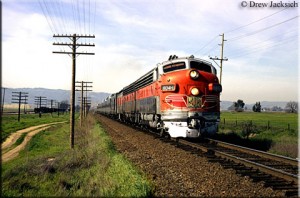Anyone who has travelled any distance on the roads in the USA will be be familiar with the intimidating phenomenon of the super sized American truck, powering up behind on their odysseys across the nation. They may also have noticed the alternative transport solution, once marginal but now increasingly relevant. In the US freight trains are vast. Often hauled by three locomotives, they seem to go on on forever, trundling with slow determination through the landscape. And, note this, progressing with three times the fuel efficiency of the truck
Back in in the UK the good citizens of leafy Buckinghamshire and Warwickshire crank up their campaign against HS2, the proposed high-speed rail way between London, Birmingham, Manchester and Scotland, building up their argument that there is no need at all for a new railway, quite apart from the damage it would do to the landscape. At the same time support for rail expansion is growing in the USA, the country where until recently you might least have expected it.
President Obama mapped out the new transport landscape in 2009, when he announced funding for a program of high-speed railway building as part of the recovery programme following the crash of 2008. The White House wants to boost funding for railways by more than $50 billion.
There was a great deal of opposition, from politicians, particularly on the right, opposed to state spending, but the list of possible new lines is taking shape, and in a land where there is so much space to put a railway, and protection of the environment is not such an emotive issue, it’s looking increasingly likely that high-speed train travel, now being so feverishly resisted in the UK, could be coming quite soon.
Recently I travelled on the fast trains on the line between Vancouver in Canada and Portland in Oregon, and now to points further south. Just a few years ago this was a skeleton service, with the few short distance trains every day. It has expanded steadily, with frequent trains, carrying more and more passengers, running from Canada to Oregon.
In California, hotbed of green strategising and low energy solutions, plans are proceeding apace for a high-speed line with trains running at up to 220 miles per hour between San Francisco and southern California. In Illinois construction on a high-speed rail route between Chicago and St. Louis is already underway.
But it is the pronouncements of one of the USA’s canniest and most successful investors, Warren Buffett, that are raising most steam in the railway world.
In his letter to shareholders in the Berkshire Hathaway company, (reports Annie Lowrey in Slate – “Warren Buffett’s big bet for the 21st century: trains.” Buffett talks about the success of an investment in the Burlington Northern Santa Fe Railway Company, one of the biggest companies running freight trains in the western United States. Last year Buffett’s Berkshire Hathaway paid $26.5 billion to buy up the 77.4 percent of BNSF it did not already own.
BNSF made a $3.6 billion profit on on $15 billion revenue in 2010, with $1 billion in net earnings to Berkshire Hathaway in the final quarter. The investor, not given to hyperbole, said the purchase was “working out even better than I expected” and calls it the “highlight” of his year.
Buffett described his deal as: “an all-in wager on the economic future of the United States.” There is a very simple measure playing in his favour, the price of oil. Last year, BNSF moved each (US) ton of freight about 500 miles for a gallon of diesel fuel. That’s about three times more efficiently than long-haul trucks, even before the latest price hikes caused by unease in the Arab world. And with cheap oil surely a thing of the past, railways in the US have a growing advantage.
The nation has half the track it had in 1970, although BNSF and other companies are transporting more freight than they did then, even with those languorous locos and and clunky infrastructure. Union Pacific, the US’s biggest rail company, posted a 41 percent increase in fourth-quarter earnings and said it was recruiting thousands of workers
But is Buffett right in believing that trains are a sound 21st-century investment? The Millennium Institute, a group supporting sustainable development, totted up the potential benefits of spending $250 billion to $500 billion to improve the nation’s inter-city railways: they include removing most long-haul trucks off the road, giving millions of Americans access to high-speed passenger rail, reducing oil consumption—and increasing GDP.
It’s unlikely that too much all that money will come from public sources, just as in the UK campaigners see the proposal to spend government money on the north-south high-speed railway link as wholly unjustified: it seems that only in countries such as Germany, France and Spain is the idea of state support for the new rail projects widely accepted.
So in the US, and possibly even the UK, could the answer lie in the vast coffers of big business, the very people who found the funds to create the railroad in the first place?
For a less sanguine view of US high speed rail, click here

